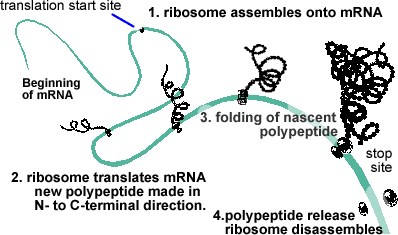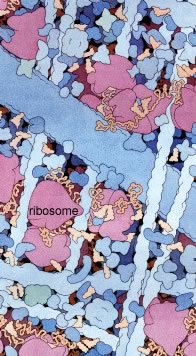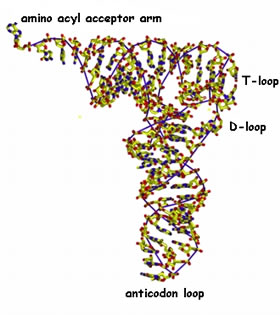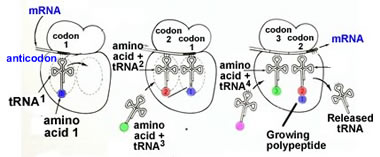|
22. Making polypeptides (and proteins)
|
Tweet | |||
|
|
|
|
DNA is more or less inert, it acts simply to store information. For that information to be used and useful, it must be transformed first into RNA; this process is known as transcription. It is called transcription because there is no "change in language"; information is encoded in the same way, through the sequence of bases in both DNA and RNA. |
|
Transcription is mediated by DNA-dependent, RNA polymerase, an enzyme that builds an RNA molecule using a DNA molecule. We will return to consider the process of transcription and its regulation later when we come to Genomes and Genes (reading 26) and Regulatory networks (reading 27). When the information is to be used to produce a polypeptide, the RNA is known as a messenger RNA or mRNA. The information in the mRNA will then be translated from a nucleotide into a polypeptide sequence. This process involves a large macromolecular complex, the ribosome, and various accessory factors. |
|
The sequence of nucleotides in DNA is related to the final sequence of the polypeptide by the genetic code. The genetic code is not the information itself, but the algorithm by which nucleotide sequences encode polypeptide sequences. The code consist of codons, which are nucleotides, read three at a time without spaces. Since there are 4 nucleotides, there are 43 (or 64) possible codons. Since all organisms use the same 20 amino acids, the code is redundant - certain amino acids are encoded for by more than one codon. There are also three codons, UAA, UAG and UGA that encode "stops" or periods. |
|
|
|
|
In addition to the common 20 amino/imino acids, there are times when other amino acids are used, in particular selenocysteine and pyrrolysine. In the case of selenocysteine, the amino acid is encoded by a stop codon, UGA, that is in a particular context within the RNA [see here for more details - totally optional]. |
| In the case of pyrrolysine, coding also involves a stop codon. In this case, a gene encodes a special tRNA that recognizes the normal stop codon UAG (and is charged with pyrrolysine - see below). |
|
|
|
There are a number of hypotheses on the origin of the genetic code, from the frozen accident model, to one in which specific interactions between RNAs and amino acids play an important role. What these unusual amino acids, and other variations in the genetic code (see here), illustrate is that evolutionary mechanisms can change the genetic code. Since it does not appear to be "predetermined", the general conservation of the genetic code among organisms is seen as strong evidence that all organisms (even the ones with minor variations in the genetic code) are derived from a single common ancestor. It appears that the genetic code is a homologous trait between all organisms. |
|
|
|
|
|
|
Translation involves a complex cellular organelle, the ribosome, which together with a number of accessory factors, including transfer or tRNAs, reads the code in an mRNA and produces the appropriate polypeptide. [can't stop yourself? click here for a more detailed description of translation.] In general (but not always), the first 5' AUG in the mRNA, which encodes the amino acid methionine, serves to mark the start of translation. |
|
Ribosomes are composed of roughly equal amounts of ribosomal (rRNAs) and ribosomal polypeptides. An active ribosome is composed of a small and a large ribosomal subunit. The complete ribosome has a molecular weight of ~3 x 106 daltons. A evolutionarily conserved catalytic rRNA, a ribozyme, lies at the heart of the ribosome - it catalyzes the addition of amino acids to the growing polypeptide chain. |
 |
 |
The cytoplasm of cells is packed with ribosomes. In a rapidly growing bacterial cell, approximately 25% of the total cell mass is ribosomes. Although structurally similar, there are characteristic differences between the ribosomes of bacteria and eukaryotes. This is important from a practical perspective. For example, a number of antibiotics selectively inhibit translation by bacterial, but not eukaryotic ribosomes. Both chloroplasts and mitochondria have ribosomes of the bacterial type. This is yet another piece of evidence that chloroplasts and mitochondria are descended from bacterial endosymbionts. A David S. Goodsell image. |
|
The small and large subunits of the ribosome remain separate until they find an mRNA. Together with accessory factors, they associate with the mRNA and assemble into a functional ribosome, which then translates the mRNA. When the ribosome reaches the end of the region of the RNA that encodes the polypeptide (defined by a stop codon), it is released, disassembles and is ready to start another cycle. |
 |
 |
Key translation accessory factors are the transfer RNAs or tRNA. These are small, L-shaped RNAs. There are specific tRNAs for each amino acid. For example, a tRNA specific for phenylalanine would be written tRNAPhe. Enzymes, amino acyl tRNA synthetases, recognize specific tRNAs and catalyze the attachment of the appropriate amino acid to the tRNA's acceptor stem. A codon in an mRNA is recognized by the anticodon in the tRNA molecule. |
 |
Accessory factors are associated with translation initiation, elongation and termination. The mRNA moves through the ribosome, bringing one codon after another into place. Each codon is recognized by an amino acid-charged tRNA. |
|
This is a stochastic process , on average many amino-acid charged tRNAs will collide with the ribosome before the "right" one (determined by the codon-anti-codon interaction), hits and binds productively. Once in place, the ribosome catalyzes the formation of a peptide bond and the transfer of the growing or nascent polypeptide to the newly arrived amino acid-charged tRNA and the release of the now uncharged tRNA. What is (seriously) unrealistic about this tutorial?→ |
|
|
|
Questions to answer
|
|
|
Questions to ponder
|
|
|
|
| replace with revised beSocratic activity |
|
|
|
modified
21-Jun-2014
|